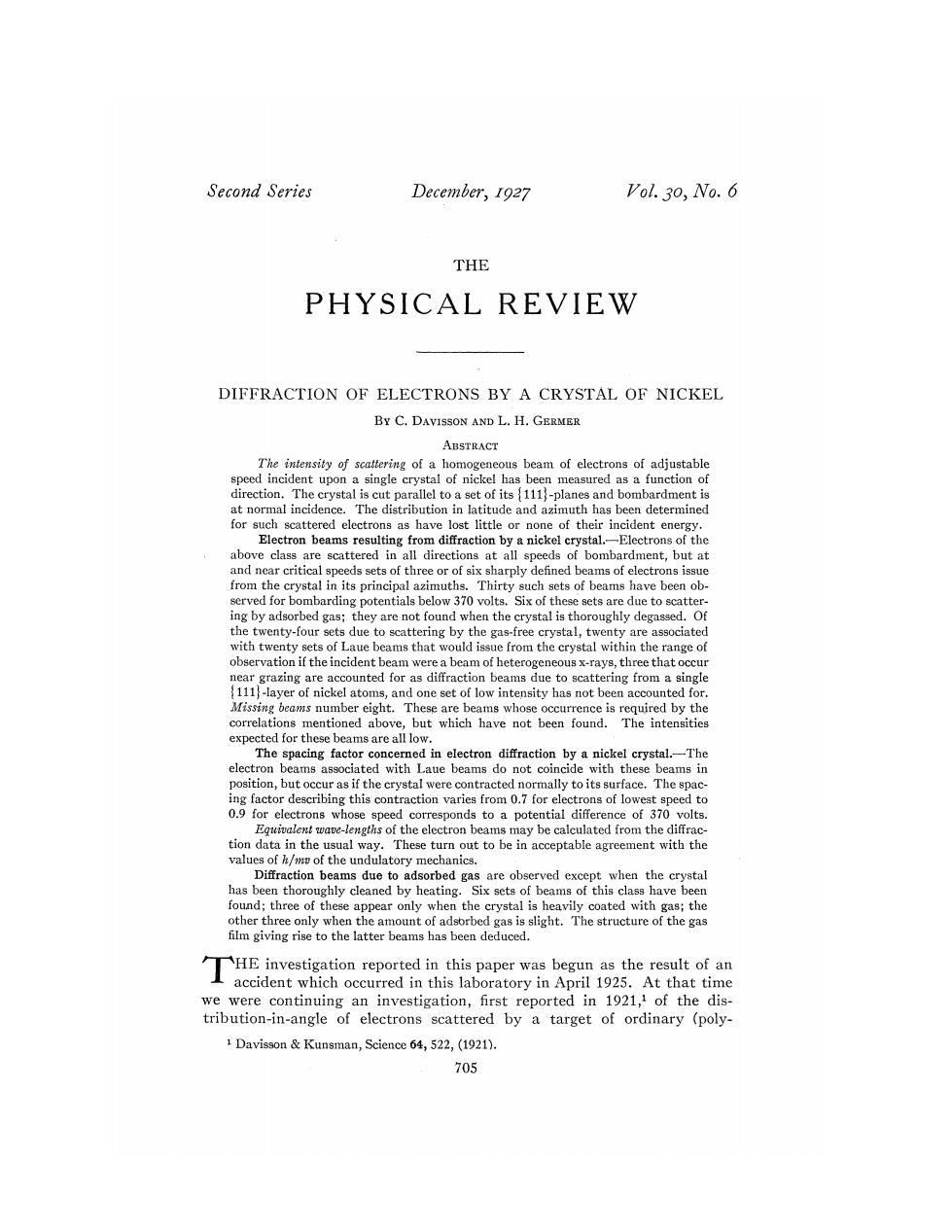
Second Series December,1927 'ol.30,No.6 THE PHYSICAL REVIEW DIFFRACTION OF ELECTRONS BY A CRYSTAL OF NICKEL BY C.DAVISSON AND L.H.GERMER ABSTRACT The intensity of scattering of a homogeneous beam of electrons of adjustable speed incident upon a single crystal of nickel has been measured as a function of direction.The crystal is cut parallel to a set of its111-planes and bombardment is at normal incidence.The distribution in latitude and azimuth has been determined for such scattered electrons as have lost little or none of their incident energy. Electron beams resulting from diffraction by a nickel crystal.-Electrons of the above class are scattered in all directions at all speeds of bombardment,but at and near critical speeds sets of three or of six sharply defined beams of electrons issue from the crystal in its principal azimuths.Thirty such sets of beams have been ob- served for bombarding potentials below 370 volts.Six of these sets are due to scatter- ing by adsorbed gas;they are not found when the crystal is thoroughly degassed.Of the twenty-four sets due to scattering by the gas-free crystal,twenty are associated with twenty sets of Laue beams that would issue from the crystal within the range of observation if the incident beam were a beam of heterogeneous x-rays,three that occur near grazing are accounted for as diffraction beams due to scattering from a single 111-layer of nickel atoms,and one set of low intensity has not been accounted for. Missing beams number eight.These are beams whose occurrence is required by the correlations mentioned above,but which have not been found.The intensities expected for these beams are all low. The spacing factor concerned in electron diffraction by a nickel crystal.-The electron beams associated with Laue beams do not coincide with these beams in position,but occur as if the crystal were contracted normally to its surface.The spac- ing factor describing this contraction varies from 0.7 for electrons of lowest speed to 0.9 for electrons whose speed corresponds to a potential difference of 370 volts. Eguivalent wave-lengths of the electron beams may be calculated from the diffrac- tion data in the usual way.These turn out to be in acceptable agreement with the values of h/mn of the undulatory mechanics. Diffraction beams due to adsorbed gas are observed except when the crystal has been thoroughly cleaned by heating.Six sets of beams of this class have been found;three of these appear only when the crystal is heavily coated with gas;the other three only when the amount of adsorbed gas is slight.The structure of the gas film giving rise to the latter beams has been deduced. HE investigation reported in this paper was begun as the result of an accident which occurred in this laboratory in April 1925.At that time we were continuing an investigation,first reported in 1921,1 of the dis- tribution-in-angle of electrons scattered by a target of ordinary (poly- 1 Davisson Kunsman,Science 64,522,(1921). 705
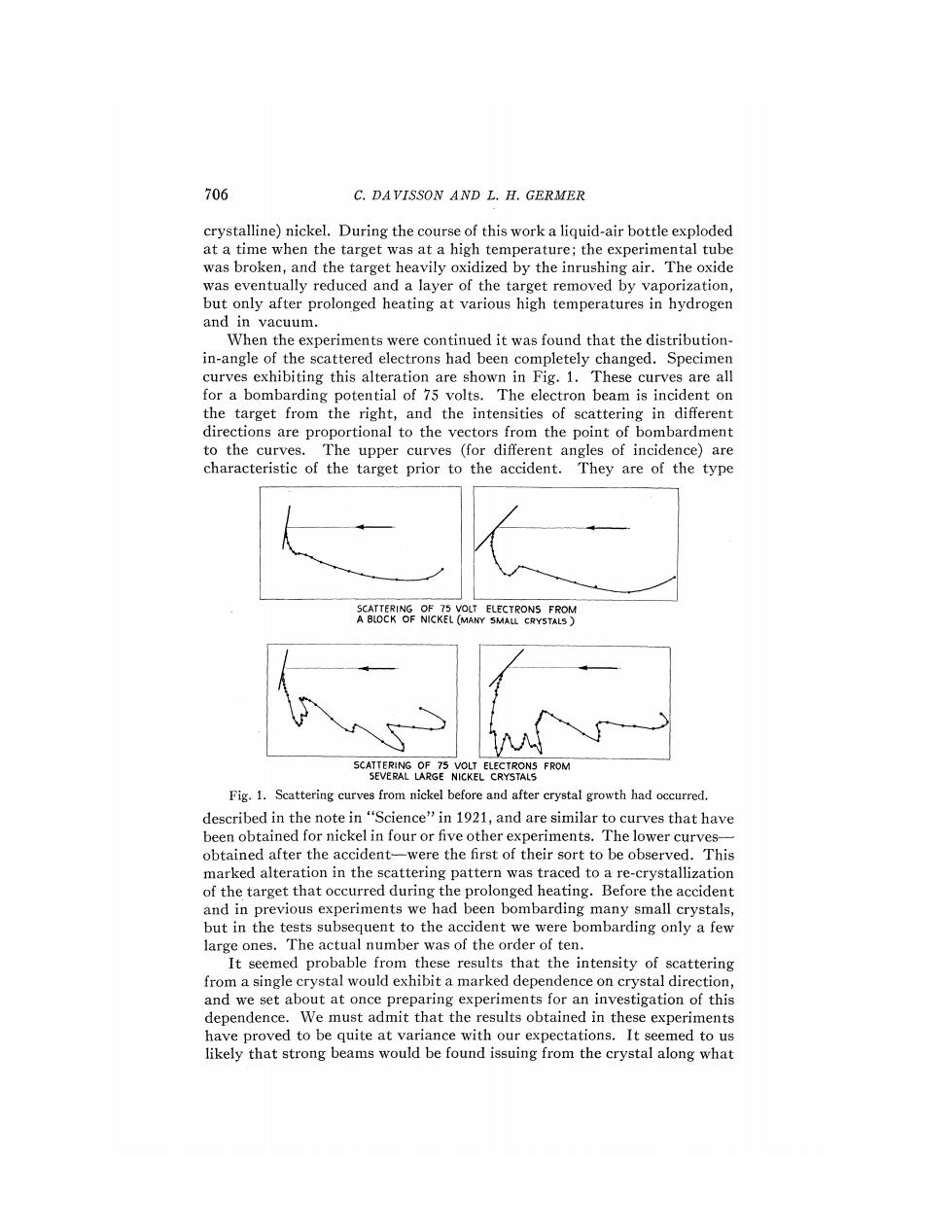
706 C.DAVISSON AND L.H.GERMER crystalline)nickel.During the course of this work a liquid-air bottle exploded at a time when the target was at a high temperature;the experimental tube was broken,and the target heavily oxidized by the inrushing air.The oxide was eventually reduced and a layer of the target removed by vaporization, but only after prolonged heating at various high temperatures in hydrogen and in vacuum. When the experiments were continued it was found that the distribution- in-angle of the scattered electrons had been completely changed.Specimen curves exhibiting this alteration are shown in Fig.1.These curves are all for a bombarding potential of 75 volts.The electron beam is incident on the target from the right,and the intensities of scattering in different directions are proportional to the vectors from the point of bombardment to the curves.The upper curves (for different angles of incidence)are characteristic of the target prior to the accident.They are of the type SCATTERING OF 75 VOLT ELECTRONS FROM A BLOCK OF NICKEL (MANY SMALL CRYSTALS SCATTERING OF 75 VOLT ELECTRONS FROM SEVERAL LARGE NICKEL CRYSTALS Fig.1.Scattering curves from nickel before and after crystal growth had occurred. described in the note in"Science"in 1921,and are similar to curves that have been obtained for nickel in four or five other experiments.The lower curves- obtained after the accident-were the first of their sort to be observed.This marked alteration in the scattering pattern was traced to a re-crystallization of the target that occurred during the prolonged heating.Before the accident and in previous experiments we had been bombarding many small crystals, but in the tests subsequent to the accident we were bombarding only a few large ones.The actual number was of the order of ten. It seemed probable from these results that the intensity of scattering from a single crystal would exhibit a marked dependence on crystal direction, and we set about at once preparing experiments for an investigation of this dependence.We must admit that the results obtained in these experiments have proved to be quite at variance with our expectations.It seemed to us likely that strong beams would be found issuing from the crystal along what
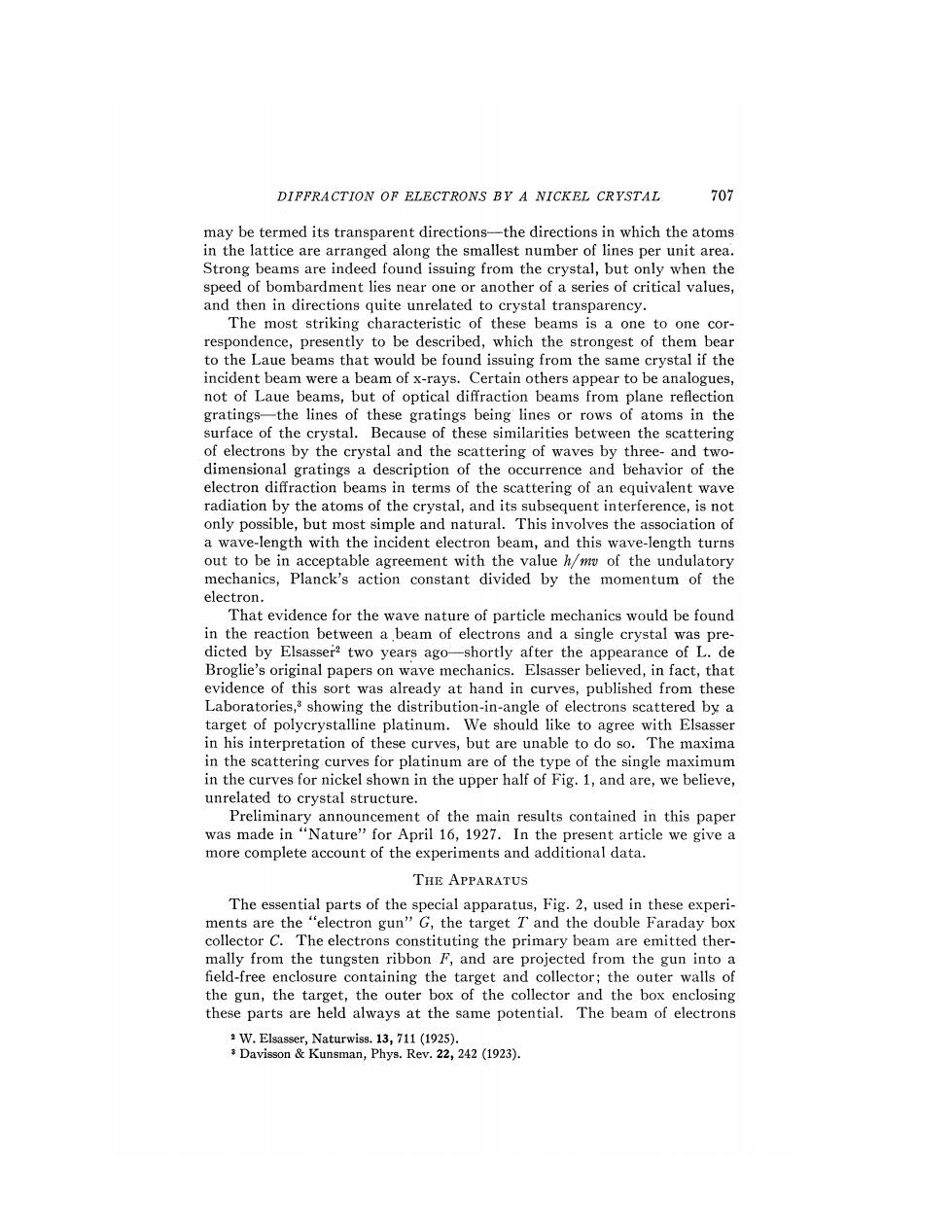
DIFFRACTION OF ELECTRONS BY A NICKEL CRYSTAL 707 may be termed its transparent directions-the directions in which the atoms in the lattice are arranged along the smallest number of lines per unit area. Strong beams are indeed found issuing from the crystal,but only when the speed of bombardment lies near one or another of a series of critical values, and then in directions quite unrelated to crystal transparency. The most striking characteristic of these beams is a one to one cor- respondence,presently to be described,which the strongest of them bear to the Laue beams that would be found issuing from the same crystal if the incident beam were a beam of x-rays.Certain others appear to be analogues, not of Laue beams,but of optical diffraction beams from plane reflection gratings-the lines of these gratings being lines or rows of atoms in the surface of the crystal.Because of these similarities between the scattering of electrons by the crystal and the scattering of waves by three-and two- dimensional gratings a description of the occurrence and behavior of the electron diffraction beams in terms of the scattering of an equivalent wave radiation by the atoms of the crystal,and its subsequent interference,is not only possible,but most simple and natural.This involves the association of a wave-length with the incident electron beam,and this wave-length turns out to be in acceptable agreement with the value h/mn of the undulatory mechanics,Planck's action constant divided by the momentum of the electron. That evidence for the wave nature of particle mechanics would be found in the reaction between a beam of electrons and a single crystal was pre- dicted by Elsasser2 two years ago-shortly after the appearance of L.de Broglie's original papers on wave mechanics.Elsasser believed,in fact,that evidence of this sort was already at hand in curves,published from these Laboratories,3 showing the distribution-in-angle of electrons scattered by a target of polycrystalline platinum.We should like to agree with Elsasser in his interpretation of these curves,but are unable to do so.The maxima in the scattering curves for platinum are of the type of the single maximum in the curves for nickel shown in the upper half of Fig.1,and are,we believe, unrelated to crystal structure. Preliminary announcement of the main results contained in this paper was made in "Nature"'for April 16,1927.In the present article we give a more complete account of the experiments and additional data. THE APPARATUS The essential parts of the special apparatus,Fig.2,used in these experi- ments are the"electron gun'G,the target T and the double Faraday box collector C.The electrons constituting the primary beam are emitted ther- mally from the tungsten ribbon f,and are projected from the gun into a field-free enclosure containing the target and collector;the outer walls of the gun,the target,the outer box of the collector and the box enclosing these parts are held always at the same potential.The beam of electrons 2 W.Elsasser,Naturwiss.13,711 (1925). Davisson Kunsman,Phys.Rev.22,242 (1923)
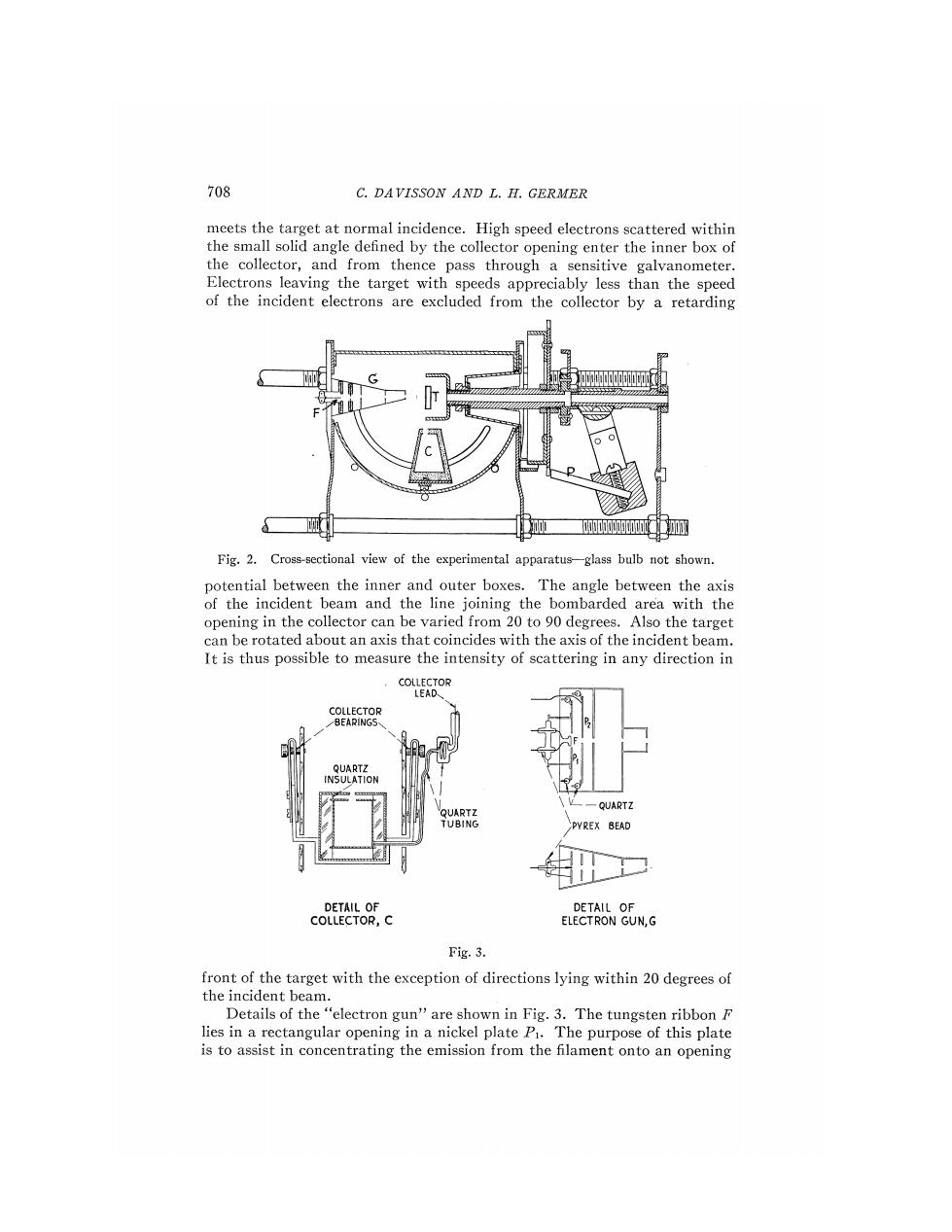
708 C.DAVISSON AND L.H.GERMER meets the target at normal incidence.High speed electrons scattered within the small solid angle defined by the collector opening enter the inner box of the collector,and from thence pass through a sensitive galvanometer. Electrons leaving the target with speeds appreciably less than the speed of the incident electrons are excluded from the collector by a retarding 000007000t00 Fig.2.Cross-sectional view of the experimental apparatus-glass bulb not shown. potential between the inner and outer boxes.The angle between the axis of the incident beam and the line joining the bombarded area with the opening in the collector can be varied from 20 to 90 degrees.Also the target can be rotated about an axis that coincides with the axis of the incident beam. It is thus possible to measure the intensity of scattering in any direction in COLLECTOR LEAD COLLECTOR BEARINGS QUARTZ INSULATION QUARTZ 一QUARTZ TUBING PYREX BEAD DETAIL OF DETAIL OF COLLECTOR,C ELECTRON GUN,G Fig.3. front of the target with the exception of directions lying within 20 degrees of the incident beam. Details of the"electron gun'are shown in Fig.3.The tungsten ribbon F lies in a rectangular opening in a nickel plate P.The purpose of this plate is to assist in concentrating the emission from the filament onto an opening
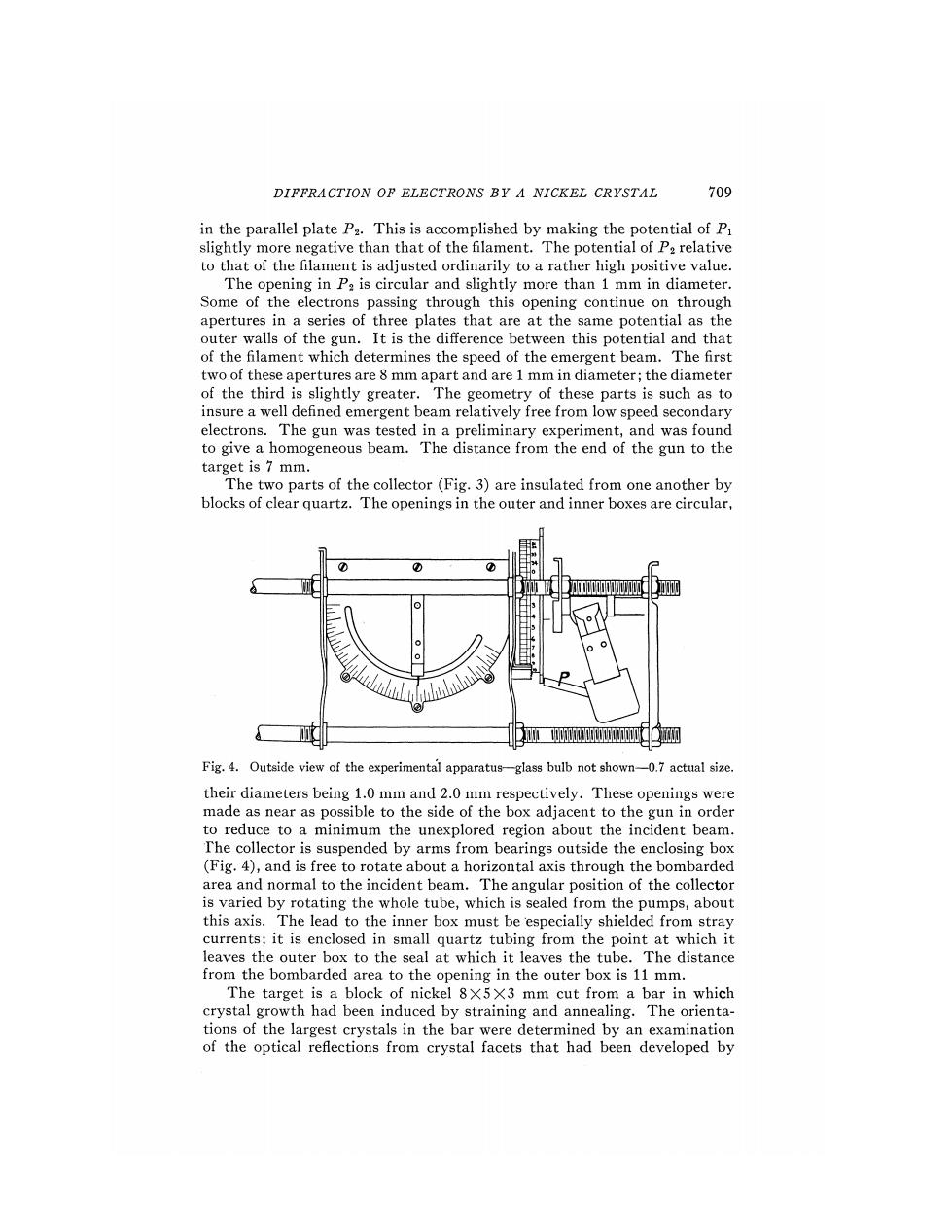
DIFFRACTION OF ELECTRONS BY A NICKEL CRYSTAL 709 in the parallel plate P2.This is accomplished by making the potential of Pi slightly more negative than that of the filament.The potential of P2 relative to that of the filament is adjusted ordinarily to a rather high positive value. The opening in P2 is circular and slightly more than 1 mm in diameter Some of the electrons passing through this opening continue on through apertures in a series of three plates that are at the same potential as the outer walls of the gun.It is the difference between this potential and that of the filament which determines the speed of the emergent beam.The first two of these apertures are 8 mm apart and are 1 mm in diameter;the diameter of the third is slightly greater.The geometry of these parts is such as to insure a well defined emergent beam relatively free from low speed secondary electrons.The gun was tested in a preliminary experiment,and was found to give a homogeneous beam.The distance from the end of the gun to the target is 7 mm. The two parts of the collector (Fig.3)are insulated from one another by blocks of clear quartz.The openings in the outer and inner boxes are circular, Fig.4.Outside view of the experimental apparatus-glass bulb not shown-0.7 actual size. their diameters being 1.0 mm and 2.0 mm respectively.These openings were made as near as possible to the side of the box adjacent to the gun in order to reduce to a minimum the unexplored region about the incident beam. The collector is suspended by arms from bearings outside the enclosing box (Fig.4),and is free to rotate about a horizontal axis through the bombarded area and normal to the incident beam.The angular position of the collector is varied by rotating the whole tube,which is sealed from the pumps,about this axis.The lead to the inner box must be especially shielded from stray currents;it is enclosed in small quartz tubing from the point at which it leaves the outer box to the seal at which it leaves the tube.The distance from the bombarded area to the opening in the outer box is 11 mm. The target is a block of nickel 8x5X3 mm cut from a bar in which crystal growth had been induced by straining and annealing.The orienta- tions of the largest crystals in the bar were determined by an examination of the optical reflections from crystal facets that had been developed by